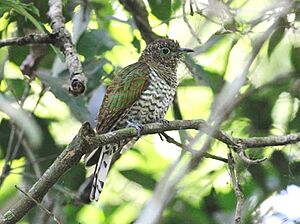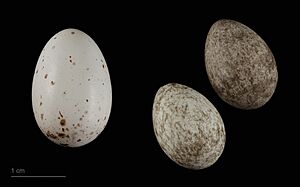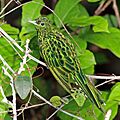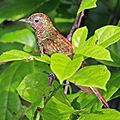African emerald cuckoo facts for kids
Quick facts for kids African emerald cuckoo |
|
|---|---|
 |
|
| Male C. c. intermedius São Tomé and Príncipe |
|
 |
|
| Female *C. c. Eshowe, KwaZulu-Natal |
|
| Conservation status | |
| Scientific classification | |
| Genus: |
Chrysococcyx
|
| Species: |
cupreus
|
The African emerald cuckoo (Chrysococcyx cupreus) is a beautiful bird found in Africa. It's a type of cuckoo known for its bright green feathers.
Contents
About the African Emerald Cuckoo
The African emerald cuckoo belongs to the cuckoo family. It's an "Old World" cuckoo, meaning it lives in Africa, Europe, and Asia. There are four slightly different types, called subspecies, of this cuckoo. These include C. c. cupreus, C. c. sharpei, C. c. intermedius, and C. c. insularum.
- C. c. cupreus: This type lives in Africa south of the Sahara Desert.
- C. c. intermedius: You can find this one on Bioko Island in the Gulf of Guinea.
- C. c. insularum: This type lives on the islands of São Tomé, Príncipe, and Annobón.
Where Do These Cuckoos Live?
African emerald cuckoos live across most of sub-Saharan Africa. This huge area includes many countries. Some of these are Angola, Botswana, Kenya, South Africa, and Uganda. They can be found in places like forests and woodlands.
What Do African Emerald Cuckoos Look Like?
These cuckoos look different depending on if they are male or female. This is called sexual dimorphism.
- Males: Male cuckoos have a shiny green back and head. Their chests are a bright yellow color.
- Females: Female cuckoos have green and brown stripes on their backs. Their chests are green and white.
You can also tell them apart by their call. It's a four-note whistle that sounds like "Hello Ju-dy."
What Do African Emerald Cuckoos Eat?
The African emerald cuckoo mainly eats insects. Their favorite foods include caterpillars and ants. They might also eat some fruit. These birds often look for food high up in the trees. They search in the middle and top parts of the forest canopy.
How Do African Emerald Cuckoos Raise Their Young?
Like many cuckoos, the African emerald cuckoo is a brood parasite. This means the female cuckoo lays her eggs in the nests of other bird species. She doesn't build her own nest or raise her own chicks.
A female cuckoo can lay many eggs during one breeding season. She might lay between 19 and 25 eggs. The breeding season usually happens during the rainy months, from September to March. Even though they don't raise their own young, male cuckoos still protect an area. They do this to attract female mates.
Are African Emerald Cuckoos in Danger?
The African emerald cuckoo lives across a very large area. This area is about 11,400,000 square kilometers (4,400,000 square miles). Because they are spread out so widely, they are not currently in danger.
However, there is some worry about their homes. Their habitats, especially forests near rivers and in lowlands, are shrinking. This could become a problem in the future.
Fun Facts and Local Names
People in different parts of Africa have special names for this cuckoo. These names often come from the bird's unique call.
- In the Zigula language, their call sounds like "ziwkulwa tuoge," which means "let's go and bathe."
- In Zulu, it's called ubantwanyana, meaning "little children." This name comes from a song that sounds like "Little children, don't get married!"
- In Xhosa, it's mostly known as intananja. Its call also sounds like "where are the girls?"
- In Afrikaans, it's called the mooimeisie, which means "pretty girl."
Images for kids







